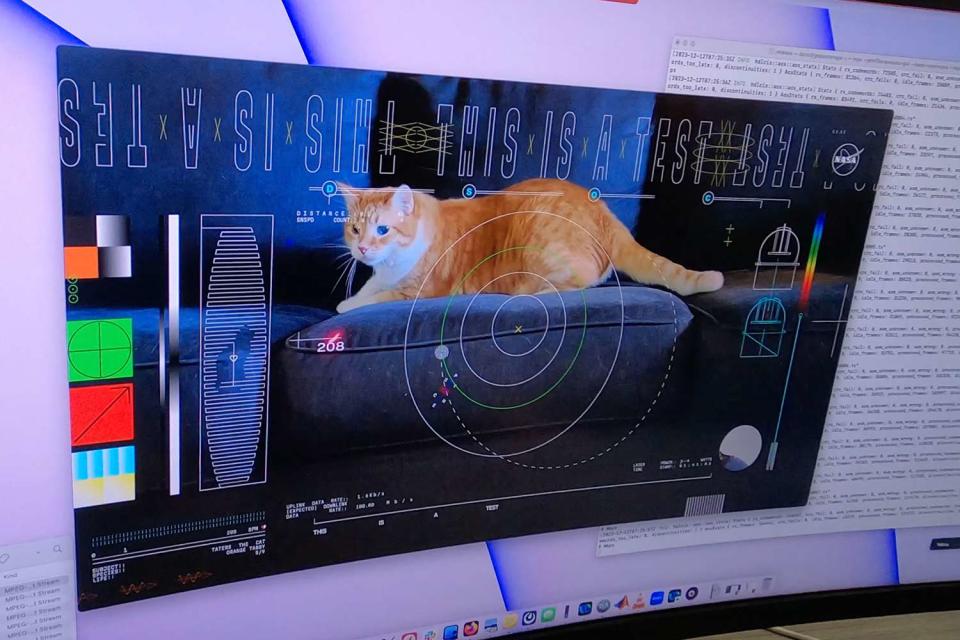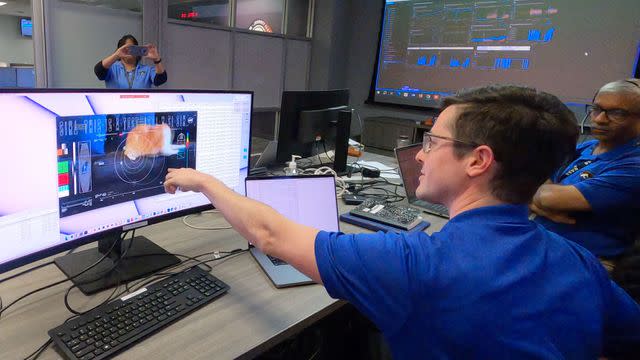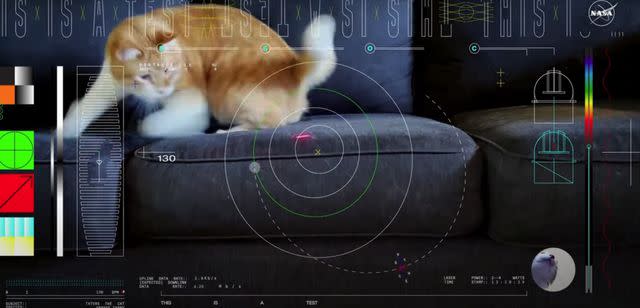NASA's First Ultra-HD Video Sent From Deep Space Stars an Orange Cat Named Taters — Watch!
"Everyone loves Taters," NASA's Jet Propulsion Lab said of the cute clip

NASA/JPL-Caltech
Taters the cat chases laser in a video sent from deep space by NASANASA has accomplished a new technological feat — broadcasting cat videos from deep space.
On Monday, NASA's Deep Space Communication team members announced they launched an experiment last week where they sent an ultra-high definition video from space. The subject of the video wasn't a planet or star; it was an orange tabby cat named Taters.
The 15-second video successfully streamed from deep space by NASA shows the feline lounging on a blue couch before jumping to chase a laser. The clip was transmitted in ultra-HD almost 19 million miles — which is 80 times the distance between Earth and the moon, per NASA — from a probe in deep space back to Earth.
The short video was loaded on the Psyche probe in October, and it was beamed from the probe on Dec. 11. The probe is on a trajectory to travel the "main asteroid belt between Mars and Jupiter" while sending out "high-data-rate signals" to test sending high-quality transmissions and communications through space.
We just streamed the first ultra-HD video brought to you via laser from deep space. And it’s a video of Taters, a tabby cat.
This test will pave the way for high-data-rate communications in support of the next giant leap: sending humans to Mars. https://t.co/tf2hWxaHWO pic.twitter.com/c1FwybYsxA— NASA (@NASA) December 19, 2023
Related: The Best Pets Moments of 2023
"One of the goals is to demonstrate the ability to transmit broadband video across millions of miles. Nothing on Psyche generates video data, so we usually send packets of randomly generated test data," said Bill Klipstein, the tech demo's project manager at NASA's Jet Propulsion Laboratory (JPL), per NASA's release.
"But to make this significant event more memorable, we decided to work with designers at JPL to create a fun video, which captures the essence of the demo as part of the Psyche mission," he added.

NASA/JPL-Caltech
NASA employees watching the first ultra-HD streaming video beamed from deep space. The video stars an orange cat named Taters.The video was transmitted through space at a record speed of 101 seconds. The clip was sent through a flight laser transceiver, which beamed the information to Earth with an infrared laser at "267 megabits per second." The Hale Telescope at Caltech's Palomar Observatory in San Diego County, California, downloaded the video from the probe in space and sent it to play live at NASA's Jet Propulsion Laboratory.
"Despite transmitting from millions of miles away, it was able to send the video faster than most broadband internet connections," said Ryan Rogalin, the project's receiver electronics lead at JPL. "In fact, after receiving the video at Palomar, it was sent to JPL over the internet, and that connection was slower than the signal coming from deep space."

NASA/JPL-Caltech
Taters the cat chases laser in a video sent from deep space by NASAHe also noted that Taters was a hit among researchers: "JPL's DesignLab did an amazing job helping us showcase this technology — everyone loves Taters."
Never miss a story — sign up for PEOPLE's free daily newsletter to stay up-to-date on the best of what PEOPLE has to offer, from celebrity news to compelling human interest stories.
The NASA team said they hope this communication technology "paves the way" for "higher-data-rate communications" that can someday be used in a mission sending humans to Mars.
"Increasing our bandwidth is essential to achieving our future exploration and science goals, and we look forward to the continued advancement of this technology and the transformation of how we communicate during future interplanetary missions," said NASA deputy administrator Pam Melroy.
For more People news, make sure to sign up for our newsletter!
Read the original article on People.

